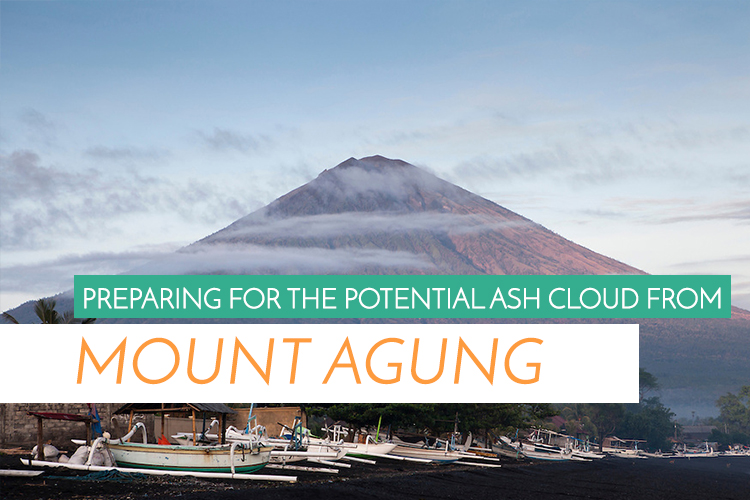
It’s all beginning to sound a little doomsday isn’t it? The hype going on in the sensationalised Australian media, the wildly spreading rumours on Facebook… If you’ve been living under a rock, you can find all the straight up facts about what is going on in our article about Mount Agung. For now, let’s talk about some simple ways to stay safe for when Mount Agung decides to erupt in the near future, so you can tell your parents to chill and stop worrying about you.
Let’s begin by saying that this is a guide we have created from numerous resources, and we by no means call ourselves experts. This article is for people who are outside of the affected region of Bali. That is, for those people who aren’t living or holidaying in East Bali right now. If you happen to be within 12km of Mount Agung it’s probably best you stop reading this, check in with local authorities and head to an evacuation center or safer location.
For those of us in towns further from the volcano, such as Ubud (33km away), we aren’t in immediate Dante’s Peak-style danger of spewing lava and falling rocks etc. (there are technical words for all of these things… but you get the point.). All that Mount Agung can possibly do to us is shower us in ash.
For this to happen a few events need to occur first. Number one, the volcano needs to actually erupt. Despite all those rumors, this has not yet happened (as of 23rd Sept). Once it erupts, the wind then needs to change directions from where it is currently blowing. We aren’t going to pretend to have any wind-reading-ash-distribution-prediction skills, but a simple read of the weather forecast could give you a insight into where the worst of the ash may head.
The following is information from Keith Lyons who has worked with Red Cross in China after a major earthquake and with environmental ministries, regional government and local authorities on disaster preparedness in New Zealand, China and Myanmar.
The danger comes from the ash cloud which can bring poisonous gases and particles which can cause health problems. It might be good to be aware of the risks, and also have a plan in case the winds bring clouds of ash your way and it drops around you.
Where is the best place to be?
The best place to be when there is ash fall is inside. If you happen to be outside, it is best to be away from low-lying areas, such as river gullies, as ash can be channeled down by winds and gravity. If you are outside, wear a mask, keep your skin covered, and wear glasses or googles. Avoid wearing contact lenses. Your Bintang singlet might not provide enough protection. Cover up vehicles, and seal buildings. Dampen down any ash or dust with water.
Currently the prevailing wind across Bali is from the south and south east, which means there isn’t so much risk of ash fall, but ash can be carried long distances before dropping, and changing weather conditions such as thunderstorms can also cause ash to fall from the sky. The further from the source, it finer it tends to be, so it can be blown for thousands of kilometres.
Stay inside, make sure windows and doors are closed. Use a mask or handkerchief for breathing if you notice ash in the air (it might seem hazy, or go darker outside as the ash blocks the sunlight). Ash is made up of very fine rock, minerals and glass, and it tends to be grey, gritty, corrosive and not dissolvable in water. Tiny ash particles, as fine as talcum powder, can be inhaled deeply into the lung, causing respiratory problems, irritating the eyes, nose and throat.
You might cough, have a runny nose, a sore throat and red eyes. Those with asthma might have shortness of breath or wheezing. Your eyes might get irritated, itchy, or bloodshot. Ash particles can scratch the eyes – if you wear contacts, take them out. Avoid heavy exertion as this might lead to deeper inhalation into the lungs. No deep breathing.
After an ash fall if you have to clean up ash, best to dampen it down first to stop it billowing, but take care as ash can be abrasive. After an eruption, if you go out, visibility may be reduced, and roads could be slippery from the ash. Your vehicle is likely to stir up more dust and ash. Ash can take out power supplies, and contaminate water supplies.
SHOULD I GO OR SHOULD I STAY?
If there is an eruption, and ash fall in your area, if you have lung or heart problems, or respiratory sensitivity, you might consider evacuation.
If the airport is closed due to ash, how can I get out of Bali?
As Denpasar has Bali’s only airport for flights, if it is closed due to ash clouds, the other option to exit Bali might be to head up to the port of Gillimanuk near Singaraja and Lovina where ferries operate throughout the day and night every 15-30 minutes for short 3km journey across to Ketapang in eastern Java, and cost just 6,000 for a passenger.
Once in Java, you are close for sightseeing if you want, to some other volcanoes such as Mt Bromo… or you could kick on to Surabaya or Yogyakarta.
WHAT SHOULD I DO IF I STAY?
Follow the advice above, and close all the windows in your house in case of an ash cloud. Buy some face masks and a poncho if you have one to wear outside (otherwise wear full-length clothing). Take out contact lenses and travel with glasses/ sunglasses. If you plan to stay inside during a potential ash cloud, stock up on water and food.
Electrical items and motors can be easily damaged from the gritty ash. It’s a good idea to seal up cameras, computers and even cover motorbikes to keep them free of damage.
Earn some extra good karma points by helping out local animals; offer them shelter, food and clean water. We will need to look out for each other if the ash cloud heads our way.
If you want more information there is a wonderful detailed guide from the New Zealand Government here. They offer great tips on how to clean up the ash as well as it can be tricky to get rid of once it falls.
Remember, these are all tips to help you through the worst case scenario. We will keep praying that this passes with little-to-no fuss, especially for the local residents surrounding Agung. We will soon provide an article of information if you wish to help out or donate to people in need. In the meantime, watch this article for updates.
AUTHOR

SARA O’BRIEN
Sara is the founder and editor of UbudHood. Originally from Australia, she has called Bali home for the last four years and has no plans to leave. With a serious love for ‘Ubud’ she has combined her love of writing and background in photojournalism to create UbudHood. She is a strong supporter of ethical tourism and believes it’s our duty, as foreigners, to respect cultures that aren’t our own. When she’s not playing with her puppies or eating her way through the hood, Sara spends her time taking photos, listening to live music or whirring herself into a creative storm of convoluted ideas.

